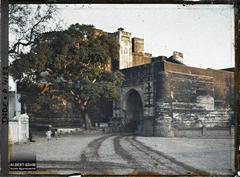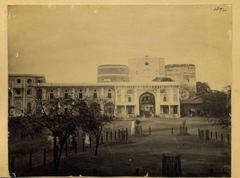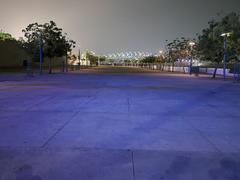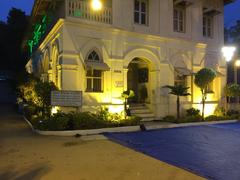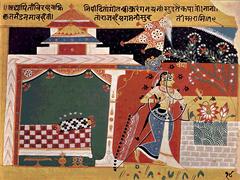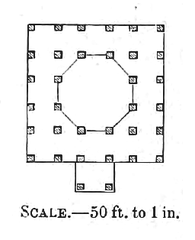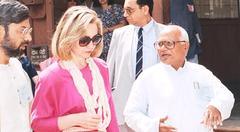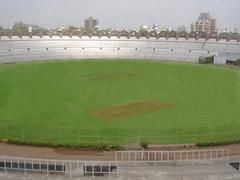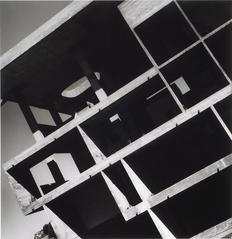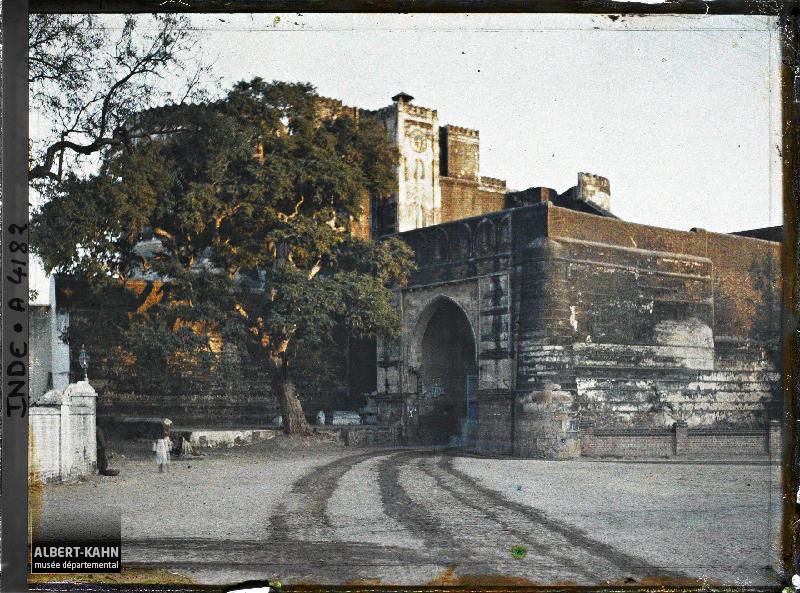
Comprehensive Guide to Visiting Bhadra Fort, Ahmedabad, India
Date: 31/07/2024
Introduction
Bhadra Fort, located in the heart of Ahmedabad, Gujarat, India, is a monumental testament to the city’s rich historical and cultural heritage. Constructed in 1411 AD by Sultan Ahmad Shah I, the founder of Ahmedabad, the fort has witnessed the city’s evolution from a burgeoning Sultanate capital to a modern urban center. The name ‘Bhadra’ is derived from the Bhadra Kali Temple within its premises, symbolizing the syncretic culture of the region (Gujarat Tourism). The fort spans approximately 43 acres and showcases a unique blend of Islamic, Hindu, and Jain architectural styles, reflecting the diverse cultural influences that have shaped Ahmedabad over centuries (Archnet).
Throughout its history, Bhadra Fort has played a pivotal role in the political and administrative activities of the region. Initially serving as the royal residence and administrative center during the Sultanate period, the fort later came under the control of the Mughal Empire in the 16th century, followed by British colonial rule in the 19th century. Each era left its mark on the fort, adding layers to its architectural and historical significance (Indian Express). In recent years, significant restoration efforts by the Ahmedabad Municipal Corporation (AMC) and the Archaeological Survey of India (ASI) have revitalized the fort, making it a popular tourist destination and a vibrant cultural hub (Times of India).
Table of Contents
- Introduction
- History of Bhadra Fort
- Visitor Information
- Special Events and Cultural Significance
- Restoration and Conservation Efforts
- Modern-Day Relevance
- Key Historical Events
- Legends and Folklore
- Conclusion
- FAQs
History of Bhadra Fort
Foundation and Early History
Bhadra Fort, located in Ahmedabad, Gujarat, India, dates back to the early 15th century. It was constructed in 1411 AD by Sultan Ahmad Shah I, the founder of Ahmedabad. The fort was named after the Bhadra Kali Temple within its premises, symbolizing the region’s syncretic culture. The fort’s construction marked the establishment of Ahmedabad as a significant urban center (Gujarat Tourism).
Architectural Significance
The architecture of Bhadra Fort is a blend of Islamic, Hindu, and Jain styles, reflecting the diverse cultural influences of the time. The fort covers an area of approximately 43 acres and includes palaces, mosques, and open spaces. The intricate carvings and latticework on the fort’s walls and gates are exemplary of the craftsmanship of the period. The fort’s main entrance, known as the Teen Darwaza, is particularly notable for its grandeur and detailed artistry (Archnet).
Role in the Sultanate Period
During the Sultanate period, Bhadra Fort served as the royal residence and administrative center. It housed the royal court and was the hub of political and cultural activities. The fort’s strategic location on the banks of the Sabarmati River provided a natural defense mechanism, making it a formidable stronghold against invasions. The fort also included a series of underground passages and secret tunnels, which were used for escape and defense purposes (Indian Express).
Mughal Era and Subsequent Changes
In the 16th century, Bhadra Fort came under the control of the Mughal Empire. The Mughals made several modifications to the fort, including the addition of new structures and the renovation of existing ones. The fort continued to serve as an administrative center and was also used as a military base. During this period, the fort witnessed several battles and sieges, reflecting the turbulent political landscape of the time (Cultural India).
British Colonial Period
With the advent of British colonial rule in the 19th century, Bhadra Fort underwent significant changes. The British used the fort as a prison and administrative office. Several parts of the fort were demolished or repurposed to suit the needs of the colonial administration. Despite these changes, the fort retained its historical and architectural significance. The British also constructed new buildings within the fort complex, some of which still stand today (Times of India).
Post-Independence Era
After India gained independence in 1947, Bhadra Fort was declared a protected monument by the Archaeological Survey of India (ASI). Efforts were made to preserve and restore the fort’s historical structures. In recent years, the fort has undergone extensive restoration work, aimed at reviving its historical and cultural heritage. The fort is now a popular tourist destination and a venue for cultural events and festivals (Ahmedabad Municipal Corporation).
Visitor Information
Visiting Hours
Bhadra Fort is open to visitors from 9:00 AM to 5:00 PM every day. It is advisable to check the official website or contact local authorities for any changes in the visiting hours before planning your visit.
Tickets and Entry Fees
The entry fee for Bhadra Fort is nominal, making it an affordable destination for tourists. For the most updated ticket prices, it is recommended to visit the official website or the ticket counter at the fort.
Travel Tips
- Best Time to Visit: The best time to visit Bhadra Fort is during the cooler months from October to March. The weather during this period is pleasant, making it ideal for exploring the fort.
- Guided Tours: Consider hiring a local guide to gain deeper insights into the history and significance of the fort. Guided tours are often available at the entrance.
- Photography: Bhadra Fort offers numerous picturesque spots. Don’t forget to carry your camera to capture the stunning architecture and landscapes.
- Nearby Attractions: While visiting Bhadra Fort, you can also explore other historical sites in Ahmedabad, such as the Sabarmati Ashram, Sidi Saiyyed Mosque, and the Jama Masjid.
- Accessibility: The fort is accessible by various modes of transportation, including buses, taxis, and auto-rickshaws. Ensure to check the local transport options for a hassle-free visit.
Special Events and Cultural Significance
Bhadra Fort holds immense cultural and historical significance. It is a symbol of Ahmedabad’s rich heritage and a testament to the city’s historical evolution. The fort’s architecture and design reflect the confluence of different cultural influences, making it a unique historical monument. The fort is also associated with several legends and folklore, adding to its mystique and allure (Gujarat Tourism).
Restoration and Conservation Efforts
In recent years, significant efforts have been made to restore and conserve Bhadra Fort. The Ahmedabad Municipal Corporation, in collaboration with various heritage conservation organizations, has undertaken several projects to preserve the fort’s historical structures and enhance its accessibility for tourists. These efforts include the restoration of the fort’s walls, gates, and other architectural elements, as well as the development of visitor facilities and amenities (Indian Express).
Modern-Day Relevance
Today, Bhadra Fort stands as a prominent historical landmark in Ahmedabad. It attracts thousands of visitors each year, who come to explore its rich history and architectural splendor. The fort is also a venue for various cultural events, exhibitions, and festivals, which celebrate the city’s heritage and traditions. The fort’s restoration and conservation efforts have not only preserved its historical significance but also revitalized it as a vibrant cultural hub (Times of India).
Key Historical Events
Several key historical events are associated with Bhadra Fort. One of the most notable is the coronation of Sultan Ahmad Shah I, which took place within the fort’s premises. The fort also witnessed several battles and sieges during the Sultanate and Mughal periods. In the 19th century, the fort played a significant role during the Indian Rebellion of 1857, when it was used as a base by the British forces. These events have left an indelible mark on the fort’s history and contributed to its enduring legacy (Cultural India).
Legends and Folklore
Bhadra Fort is steeped in legends and folklore. One popular legend is that of the Bhadra Kali Temple, which is believed to have been built by the goddess herself. Another legend speaks of a secret treasure hidden within the fort’s underground passages. These stories add to the fort’s mystique and charm, making it a fascinating destination for history enthusiasts and tourists alike (Gujarat Tourism).
Conclusion
Bhadra Fort stands as a monumental example of Ahmedabad’s rich cultural and historical tapestry. Its intricate carvings, latticework, frescoes, and inscriptions provide a glimpse into the artistic and architectural prowess of the period. The fort’s evolution from a royal residence to a colonial prison, and now a protected monument, reflects the dynamic historical journey of Ahmedabad. Today, Bhadra Fort not only serves as a significant historical landmark but also as a vibrant cultural hub, attracting thousands of visitors each year who come to immerse themselves in its grandeur (Gujarat Expert). The restoration and conservation efforts have ensured that its legacy continues to inspire and captivate visitors from around the world. Whether you are a history enthusiast, an architecture aficionado, or a curious traveler, a visit to Bhadra Fort offers a unique opportunity to explore the rich heritage of Ahmedabad (Ahmedabad Municipal Corporation).
FAQs
Q: What are the visiting hours for Bhadra Fort? A: Bhadra Fort is open to visitors from 9:00 AM to 5:00 PM every day.
Q: How much is the entry ticket for Bhadra Fort? A: The entry fee is nominal. For the most updated ticket prices, visit the official website or the ticket counter at the fort.
Q: What is the best time to visit Bhadra Fort? A: The best time to visit is from October to March when the weather is pleasant.
Q: Are guided tours available at Bhadra Fort? A: Yes, guided tours are often available at the entrance, providing deeper insights into the fort’s history.
Q: What are some nearby attractions to Bhadra Fort? A: Nearby attractions include Sabarmati Ashram, Sidi Saiyyed Mosque, and the Jama Masjid.
Q: Is Bhadra Fort accessible by public transport? A: Yes, the fort is accessible by buses, taxis, and auto-rickshaws.
References
- Gujarat Tourism. (n.d.). Bhadra Fort. Retrieved from Gujarat Tourism
- Archnet. (n.d.). Bhadra Fort. Retrieved from Archnet
- Indian Express. (2020). Ahmedabad Bhadra Fort gets a new lease of life. Retrieved from Indian Express
- Times of India. (2020). Bhadra Fort gets a new lease of life. Retrieved from Times of India
- Gujarat Expert. (n.d.). Bhadra Fort. Retrieved from Gujarat Expert
- Ahmedabad Municipal Corporation. (n.d.). Bhadra Fort. Retrieved from Ahmedabad Municipal Corporation
